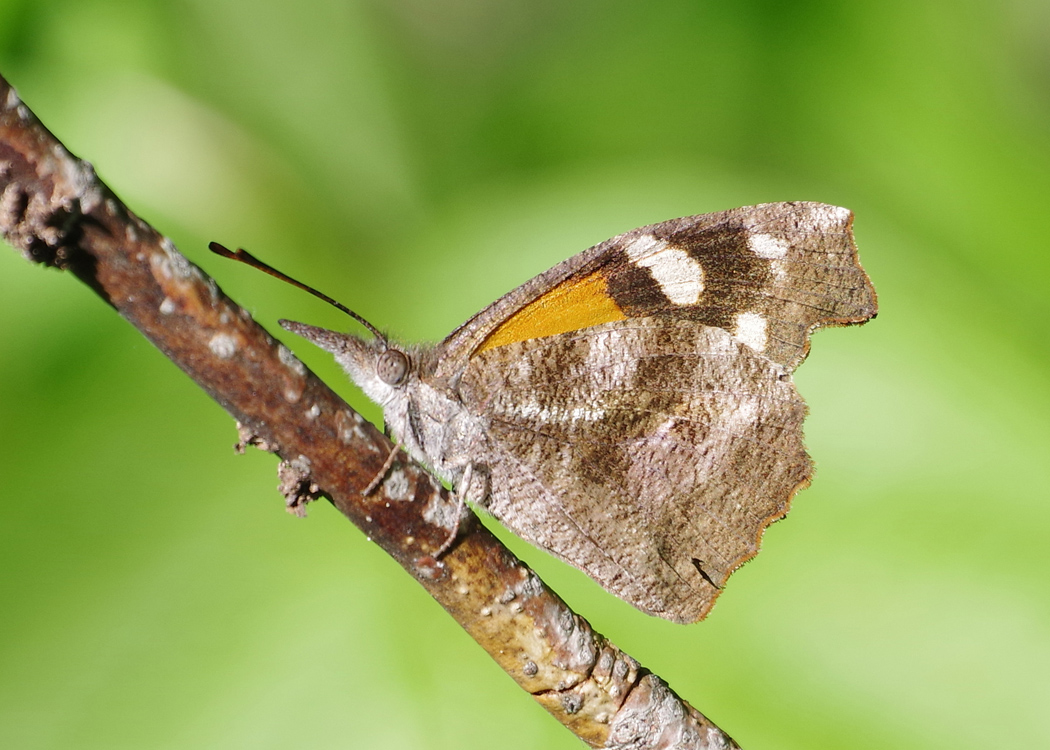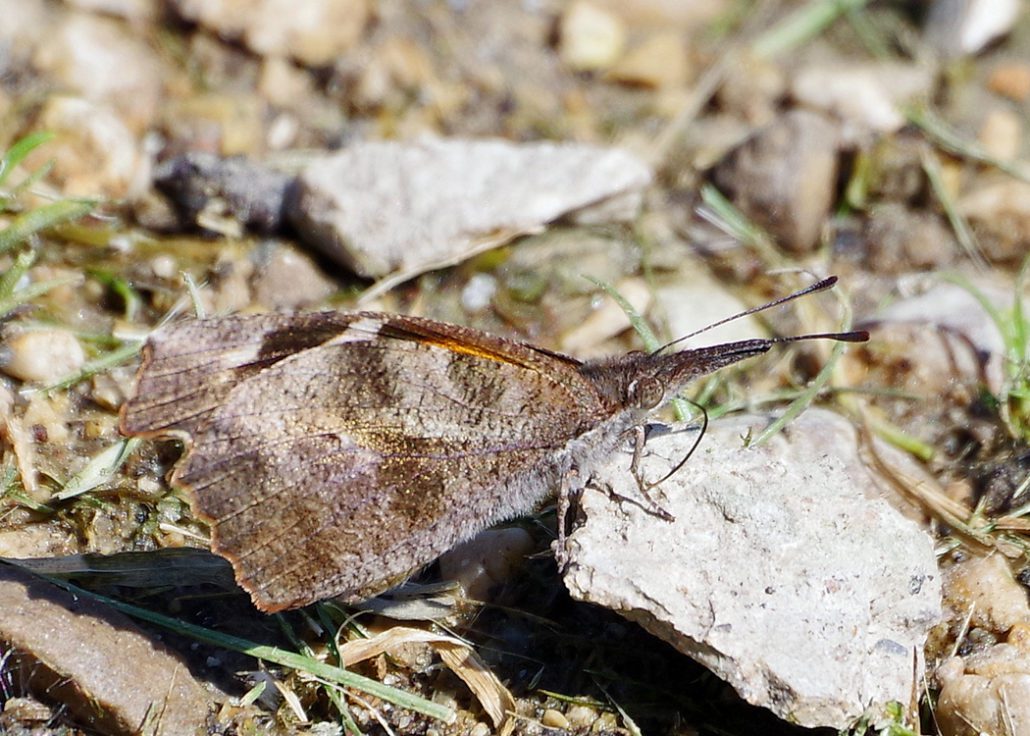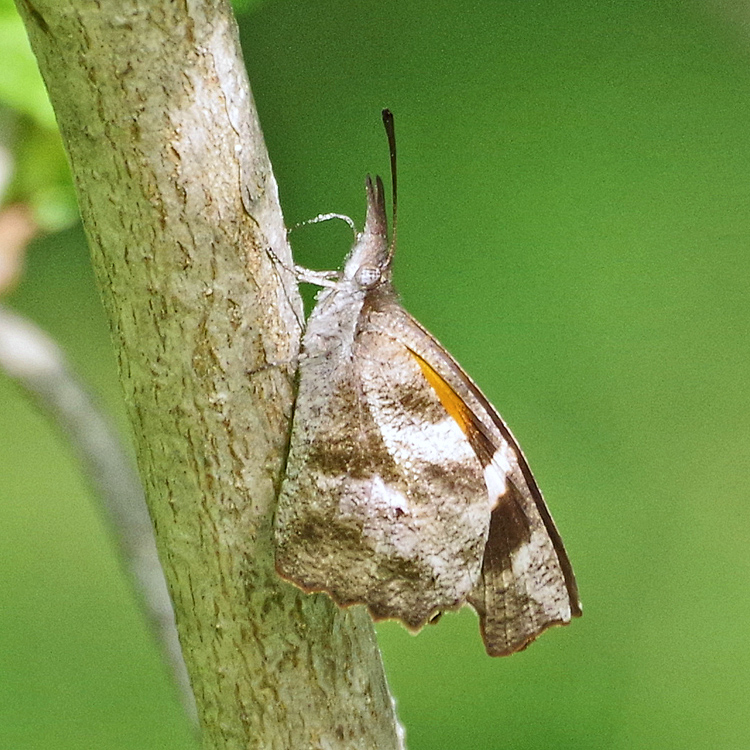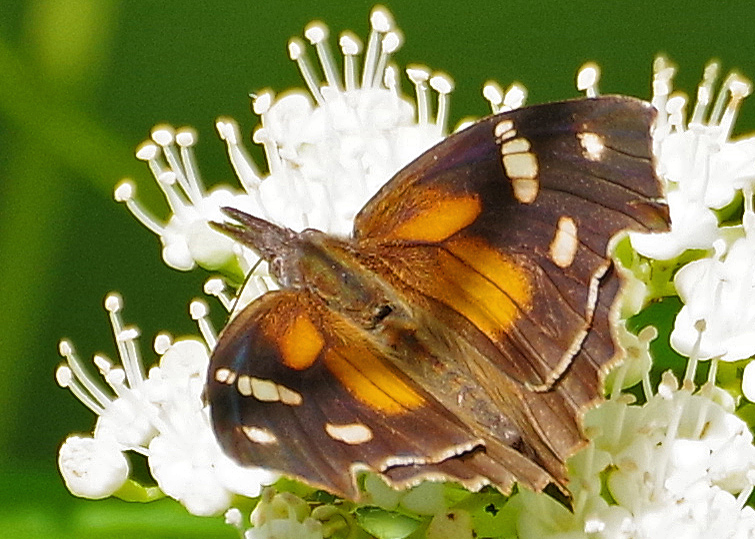
A Tale of Two Butterflies – Part 1 the American Snout
The BugLady found two interesting butterflies in mid-June – one, the American Snout, is a fairly regular visitor from the South, and the other (see next week’s BOTW) puts in rare appearances from the Southwest.
The Snout
She was walking along the river when she saw an orange and brown butterfly fluttering around near a bare area. Even though she hadn’t seen one for a long time, she was pretty sure she knew what it was (having quickly eliminated from consideration the slightly larger and more vividly-colored Red Admiral, American Lady and Painted Lady). After that first encounter, she saw several more Snouts.
Some taxonomists put them in the Brush-footed butterfly family Nymphalidae, within the subfamily Libytheinae (Snouts), and others put them in their own family Libytheidae (the Snouts or Long Beaks). There are only about eight species of snouts worldwide, all in the tropics/subtropics, and although older field guides may list several species of American Snouts, they’re presently lumped into a single species that’s divided into races, geographically. The Libytheidae are “old-timey” butterflies, whose fossilized ancestors have been found in 35 million year old deposits. It’s possible that earlier generations had some use for that snout that we haven’t figured out.

Nymphalidae is a family in which the butterfly’s front legs are greatly reduced and brush-like – essentially, they are four-legged butterflies. American Snouts (Libytheana carinenta) have tweaked that design; males get around on four legs, but females have six functional legs. Their “snout” is actually a pair of elongated mouthparts called labial palps https://bugguide.net/node/view/1542556/bgimage (the species name “carinenta” comes from a Latin word for “keel” and alludes to the shape of the palps).
When they’re perched, Snouts are pretty distinctive. With angular, variously-leafy-looking underwings https://bugguide.net/node/view/1885500/bgimage, https://bugguide.net/node/view/1253002/bgimage, https://bugguide.net/node/view/725354/bgimage, https://bugguide.net/node/view/709384/bgimage, and a head that looks like a leaf stem, they are well camouflaged. If they’re alarmed, they may flick open their wings and startle predators with a flash of orange. Their wingspread is about 1 ½ to 2 inches, and males and females look similar.

They’re found in open woods, especially near wetlands and streams, from Argentina into our Southern tier of states, where they produce multiple broods a year and overwinter as adults. They wander north of their regular range (as far as Ontario, but not to the northwestern quadrant of North America), and they sometimes undertake dramatic movements (more about that in a sec).
Snouts visit Wisconsin most years (no sightings in 2021, but good numbers this year), arriving in late spring and producing a brood, with their numbers peaking in July. Our winters are (still) too cold for them to overwinter. Early arrivals to the North Country will bask in the sun for warmth, and they can quiver the (internal) flight muscles to generate some heat for flight (muscular thermogenesis).
These are not really migrants – some authors call them “immigrants” – because there’s no corresponding southward movement in fall by subsequent generations. In Butterflies of Wisconsin (1970) Ebner says “Hoy stated the curious insect was once common in the Racine area but that it had dwindled drastically in abundance by 1881.” It is conceivable that the species is short-lived here and exterminated by a severe and prolonged winter season.” Snouts are more common in the southern part of Wisconsin because there are more of the caterpillar host trees in the south.
Their lives are tied to hackberry trees. Males patrol for females near hackberries. Several sources noted that mating pairs https://bugguide.net/node/view/234642/bgimage have been seen at dusk and at night, suggesting that they are crepuscular breeders, but others say that mating occurs at any time of day. Females lay eggs in the hackberry leaf axils, and the caterpillars https://bugguide.net/node/view/1567718/bgimage (older caterpillars are fancier https://bugguide.net/node/view/6528) hatch and feed on the leaves. Development is speedy – from egg to adult in just over two weeks! The University of Florida Entomology and Nematology’s “Featured Creatures” blog adds this wonderful side note: “When not feeding, larvae in Brazil are reported to rest on frass chains as a defense against predators.”

Because their proboscises are short, adults feed on nectar from “shallow” flowers like dogbane, aster, and goldenrod (the BugLady photographed one on Nannyberry), and they also get nutrients from bird droppings. Males use their proboscises to absorb minerals from mud puddles.
Sometimes, the dam bursts and there are Biblical movements of Snouts throughout the Southwest – For this to happen, a few dominos have to line up. The first domino is drought. Snouts go into a state of diapause (become inactive) during a drought.
The second is heavy, summer rain – when the drought breaks, the rain stimulates Spiny hackberry trees (but not other hackberry species) to grow tender, new leaves.
Third, during a drought there are fewer insects like this Chalcicid wasp https://bugguide.net/node/view/1179366 that might be parasitoids of the caterpillars, so higher numbers of caterpillars survive.
It’s the perfect storm – the rains come, the Snouts wake up, and the landscape is covered with butterflies that are eager to breed. There are, suddenly, lots of places to lay eggs, and lots of leaves for caterpillars to eat, and the population explodes. Professor Larry Gilbert found hackberries one meter in diameter with upwards of 4,000 chrysalises on them https://bugguide.net/node/view/6527/bgimage, https://bugguide.net/node/view/234621/bgimage (this one holds an almost-mature butterfly!). Gilbert estimated that in 1978, the number of Snouts produced on the Chaparral Wildlife Management Area in Texas was about one-half billion (get the full story here http://texasento.net/snout.htm).
After the caterpillars defoliate the hackberries and metamorphose into adults, the Snouts spread out, moving at five to eight miles per hour, looking for more hackberries, hopscotching from one suitable spot to the next Clouds of butterflies block the sun, lower visibility on the interstate, gum up windshields and radiators, and cause street lights to go on! You would think that there would be a bunch of images of this on the internet, but there aren’t.
And here’s an excerpt from an article in the Texas Parks and Wildlife publication by Ben Hutchins, about an earlier event: “In 1921, an estimated 75 million butterflies per hour passed through South Texas in a particularly large wave that stretched for nearly 250 miles. To put that in perspective, the entire eastern monarch population during the winter of 2016-2017 was estimated at just over 81 million individuals. That’s essentially every monarch in North America east of the Rockies, save for a few snowbirds that hang out around the Gulf Coast, compared to 75 million American snouts passing by in a single swarm, in a single hour. The flight lasted for 18 days.”
The wonderful Butterflies of Massachusetts account reports that Snout sightings had increased in New Jersey and New York by the end of the last century, which suggests that their range could expand northward as the climate warms.
It’s not too late to see one this year.
Kate Redmond, The BugLady
Bug of the Week archives:
http://uwm.edu/field-station/category/bug-of-the-week/
